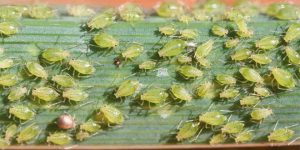Aphids, Woolly and Otherwise
By Lynne Pieri-Finn, Fairfax Master Gardener Intern
 Aphids are tiny insects shaped like pears in an array of colors. There are around 4,000 species. They are usually wingless but if a colony is crowded, some females can fly over to another source of nourishment. Of course, they may be blown by the wind, too. Aphids have tube-like protrusions to suck the life juices out of many different types of plants, resulting in curled, yellow or distorted leaves, stunted shoots, malformed blooms, even galls.
Aphids are tiny insects shaped like pears in an array of colors. There are around 4,000 species. They are usually wingless but if a colony is crowded, some females can fly over to another source of nourishment. Of course, they may be blown by the wind, too. Aphids have tube-like protrusions to suck the life juices out of many different types of plants, resulting in curled, yellow or distorted leaves, stunted shoots, malformed blooms, even galls.
Aphids excrete a sticky substance called ‘honeydew’ which often turns into black sooty mold. Honeydew falls onto the upper surface of leaves below where the aphids are feeding, so sooty mold may appear on plants that are otherwise free of pests. The only solution for sooty mold, short of washing or rubbing the individual leaves, is to get rid of the aphids above.
Thankfully, there are many bugs that love to eat aphids such as ladybugs, lacewings, praying mantis, thrips, rove beetles, spiders, big-eyed bugs, braconid wasps, chalcid wasps and damsel bugs. There are other control measures the gardener can take, too, depending upon where the infestation occurs. Please consult the Pest Management Guide for more information. One may blast aphids off plants with a shot of the hose. Aphid eggs can survive in the winter in bark and old leaves, so be sure to clean up old plant debris in the fall.
“Big brother” ants protect and herd aphids around. When one plant part is destroyed, the ants direct the aphids to other plant parts, in case they are too slow on the uptake. If the weather is bad they invite them into their nests. They even pamper them with massages so they product more honeydew.
If one sees sooty mold on some plants, look up. Is there a tree there? Consider ringing it with sticky bands or something the ants can’t climb. Don’t give the aphids more encouragement.
Root aphids are more difficult to control than those that feed on foliage. Infested plants tend to have reduced vigor. One may see a white powdery wax on the roots and surrounding soil. Crop rotation may help control root aphids that have overwintered in the soil.
There are some plants that one can add such as onions, chives and garlic that are said to have deterrent properties. I understand that Egyptian onions are quite ornamental, and chives and garlic look good around roses. Why not?

Woolly aphids
Aphids are common and numerous but can be managed with a little patience and know-how.
References
• 2018 VA Pest Management Guide, Table 2.2.3, Table 4.5, and Table 4.10
• Aphids, VCE Publication 444-220, November 3, 2014
• American Horticultural Society Pests and Diseases, Pippa Greenwood. Dorling Kindersley Publishing,
New York, 2000
• Garden Insects of North America, Whitney Cranshaw. Princeton University Press, 2004
• Pests, Elizabeth and Crow Miller. Workman Publishing, New York, 2000
• The Gardeners Guide to Common-Sense Pest Control, William Olkowski, Tauton Press, Newtown,
Connecticut, 2013